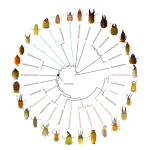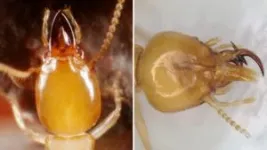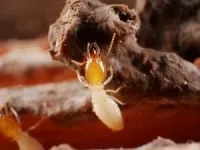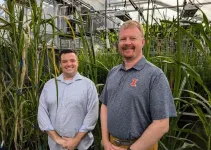(Press-News.org) Termites have a bad reputation. Most think of them as pests, a status that isn’t helped by their recent reclassification into the cockroach family.
But not only do the termites that cause serious problems for humans only make up 3.5% of all termite species, termites also serve as crucial ecosystem engineers, maintaining the infrastructure of various environments. Like earthworms, they circulate nutrients by decomposing plant materials, and they play the important role of bioturbators: much like plowing a field, termites aerate the soil, expose underground nutrients, and let water infiltrate deeper layers of soil – all vital to plant life. Termites are also exemplary builders: their mounds stay cool under the blistering sun, inspiring energy-free air conditioning systems in smart architecture.
Just as many ecosystems rely on the infrastructure provided by termites, so too does the study of termites require a solid foundation. And now, a new system for termite classification has been created thanks to the effort of no less than 46 researchers from across the world. Their work, built on expert consensus and extensive data analyses, has now been published in Nature Communications. “We have resolved the ambiguity of the previous system with a modular and very robust classification of the termite family,” says Dr. Simon Hellemans, lead author and member of the Evolutionary Genomics Unit at the Okinawa Institute of Science and Technology (OIST). “With this new ‘dictionary,’ we have a solid platform from which we can study the diversification of termites and the roles they play in their ecosystems, as well as accommodate future discoveries.”
A family reunited through distinction
Taxonomy, the scientific classification of groups (or taxa) of organisms, is an old discipline that underpins all biology: “If you want to observe anything in nature, you need define your units of observation,” as Dr. Hellemans puts it. Classification may be arbitrary – the animal doesn’t care if we label it Heterotermitidae or Rhinotermitidae – but it’s a necessary categorization that allows researchers to limit the scope of their study and communicate clearly. Until the introduction of modern DNA sequencing, these distinctions were usually based on morphological analyses, whereby organisms are classified by their physical characteristics and behaviors and placed in relation to one another based on similarities. But while it may be easy to determine how chimpanzees and humans are different from gorillas, visually determining the difference between two termites may be more difficult.
Over time, the subjectivity of morphological analysis has led to a convoluted family tree for termites. Some termites diversify very quickly, meaning that those species have evolved rapidly compared to others. And yet, just ten distinct families were identified, which had to accommodate a lot of morphologically distinct animals with unclear evolutionary relationships.
Three terms are used to describe the relationship between grouped species: monophyly, polyphyly and paraphyly: a monophyletic group of species share a common ancestor, polyphyletic groups often share common characteristics, but not a common ancestor, and paraphyly describes groups that include a common ancestor as well as some, but not all, descendants. The problem with termites, which is a monophyletic group within the cockroach order, is that the traditional classification is characterized by a great deal of paraphyly and polyphyly owing to the confusion over evolutionary relationships.
“Thanks to extensive data analysis and new morphological surveys, we managed to eliminate paraphyly and polyphyly in the termite family tree entirely by splitting up the larger subfamilies,” explains Dr. Hellemans, “and in doing so, we have created a system that can effectively accommodate the discovery of new lineages while preserving historical family and subfamily names. This is key to providing a stable termite nomenclature. Taxonomy is also built on historical records, so this is very important.”
Every family and subfamily within the new termite tree of life is monophyletic, clearing up the evolutionary relationships between the species and making it significantly easier to slot in newly discovered or reclassified species. The new tree also underscores the diversity of termites, which allows for much greater precision in research and pest control. For example, the Coptotermes gestroi, a destructive pest species of termites, was initially classified in the Rhinotermitidae family along with the non-pest Dolichorhinotermes longilabius due to their morphological similarities. However, early phylogenetic studies suggested that these two species might not be closely related, which has now been confirmed through more advanced phylogenetic and morphological surveys, which reclassified C. gestroi into the Heterotermitidae family.
Building the foundation together
Rewriting the dictionary of life is no simple feat. More than anything, it takes consensus – after all, a dictionary is useless if there’s disagreement over the definitions.
The work to update the termite tree of life began during a symposium at OIST in 2022, which was organized by Professor Tom Bourguignon, head of the Evolutionary Genomics Unit. Here, the unit proposed a framework for revising the tree of life, which included both morphological surveys and data analyses powered by the supercomputer at OIST. Phylogenetic revisions of classification systems are often based on a data model that can take weeks for a supercomputer to calculate, and each time an adjustment is made, the processing begins anew. “Our classification is based on the convergence of 51 models, each of which took around 2 weeks to compute,” recounts Dr. Hellemans. “This was only possible thanks to Deigo, which allowed us to run the analyses in parallel.” Deigo is the name of the main supercomputing cluster operated by the OIST Core Facilities, named after the prefectural flower of Okinawa and available to all OIST researchers.
“Phylogenetics cannot stand alone,” stresses Dr. Hellemans. While the researchers used computational models of DNA markers to ascertain the evolutionary relationship between the families, the models do not account for the termites’ habits nor the roles they play in their environments. This knowledge was instead provided by the human experts who have dedicated their lives to one subset of our living world and who have an invaluable, scientific familiarity with the species they study. Dr. Hellemans summarizes the effort: “Even if it was difficult to coordinate a collaborative project of this size, the new termite classification system is greater than the sum of its parts. With this, we have a much stronger framework for the study of these important ecosystem engineers.”
END
The dictionary of termites has been rewritten
A robust classification system for termites has been developed with expert consensus and powerful modelling.
2024-09-05
ELSE PRESS RELEASES FROM THIS DATE:
CABBI team designs efficient bioenergy crops that need less water to grow
2024-09-05
Drought stress has long been a limiting factor for crop production around the world, a challenge exacerbated by climate change.
For more than a century, scientists have targeted a key plant trait known as water use efficiency (WUE) to help crops grow with less water and avoid suffering from drought stress. Greater WUE can help plants avoid drought stress — but for most crops it’s also associated with lower productivity when water is plentiful.
In a pair of new studies published in the Journal of Experimental Botany, ...
Texas A&M researchers discover that sustained neck exertions change the spine and muscles, causing pain
2024-09-05
Learning new languages, sending emails, attending a virtual class, or speaking to loved ones halfway around the world are just some of the tasks accomplished by touching a button on a smartphone. Unfortunately, the ease and convenience of modern devices have also come with a painful crick in the neck. The sedentary nature of work and prolonged use of hand-held devices and computers have contributed to a sharp increase in neck pain.
While fatigue in neck muscles has long been suspected of causing pain, the actual mechanical changes in the spine and muscles that precede weakness remain an outstanding question.
Now, using high-precision X-ray ...
Air pollution linked to higher risk of infertility in men
2024-09-05
Long term exposure to fine particulate matter (PM2.5) air pollution is linked to a higher risk of infertility in men, whereas road traffic noise is linked to a higher risk of infertility in women over 35, finds a Danish study published by The BMJ today.
If these findings are confirmed in future studies, they could help guide strategies to regulate noise and air pollution to protect the general population from these exposures, say the researchers.
Infertility is a major global health problem affecting one in seven couples trying to conceive.
Several ...
Prostate cancer rates across Europe since 1980 “indicative of overdiagnosis” say experts
2024-09-05
Rates of prostate cancer across Europe since 1980 are “indicative of overdiagnosis”, say researchers in a study published by The BMJ today.
Overdiagnosis refers to the detection of harmless cancers that are unlikely to cause symptoms or death during a patient’s lifetime, which can lead to unnecessary treatment, negative impacts on quality of life, and wasted healthcare resources.
The findings show rapid increases in the number of new cases (incidence) in parallel with uptake of so far predominantly opportunistic ...
Children switch to walking and cycling to school after introduction of London’s Ultra-Low Emission Zone
2024-09-05
Four in ten children in Central London who travelled to school by car switched to more active modes of transport, such as walking, cycling, or public transport, following the introduction of the Ultra-Low Emission Zone (ULEZ), according to new research. In the comparison area with no ULEZ, Luton, only two in ten children made this switch over the same period.
Car travel contributes to air pollution, a major cause of heart and lung diseases including asthma attacks. Beyond this, it limits children's opportunities for physical activity, hindering their development and mental health, and increasing their risk of obesity and chronic illnesses.
Despite ...
Three top ways to stop smoking
2024-09-05
A major new scientific review of evidence published in the journal Addiction has identified three top strategies for quitting smoking:
Varenicline -- a prescription drug sold under the brand names Chantix and Champix among others.
Cytisine -- a plant-based compound available under prescription in the United Kingdom, in Canada as an over-the-counter natural health product (Cravv®) and throughout central and eastern Europe.
Nicotine e-cigarettes.
These work best when combined with behavioural support, ...
Scientific review reveals top three effective ways to stop smoking
2024-09-05
A major new review of evidence by a team of scientists, including a University of Massachusetts Amherst public health researcher, has identified the three best strategies for quitting smoking:
Varenicline – a prescription drug sold under the brand names Chantix and Champix, among others.
Cytisine – a plant-based compound not widely available in the U.S. but sold as an over-the-counter natural health product (Cravv®) in Canada and throughout Central and Eastern Europe, and available under prescription in the United Kingdom.
Nicotine e-cigarettes.
The review, published ...
HudsonAlpha researchers awarded NIH grant to identify genetic contributors to rare diseases in children
2024-09-05
As genetic sequencing technology becomes more accessible and efficient, researchers have made significant strides in understanding the genetic underpinnings of various diseases. This knowledge has led to a surge in clinical applications of genetic testing, offering hope and improved outcomes for individuals affected by many genetic diseases and disorders. Despite these successes, scientists continue to try to improve genetic testing technologies, because many individuals with rare diseases remain undiagnosed even after current state-of-the-art genomic testing.
Scientists at the HudsonAlpha Institute for Biotechnology ...
The signals in your brain that tell you when It’s time to move
2024-09-05
A new study, published in Nature Communications this week, led by Jake Gavenas PhD, while he was a PhD student at the Brain Institute at Chapman University, and co-authored by two faculty members of the Brain Institute, Uri Maoz and Aaron Schurger, examines how the brain initiates spontaneous actions. In addition to demonstrating how spontaneous action emerges without environmental input, this study has implications for the origins of slow ramping of neural activity before movement onset—a commonly-observed but poorly understood ...
Hudson River Foundation awards $1.7 million to Cary Institute for river monitoring program
2024-09-04
(Millbrook, NY) The Hudson River Foundation for Science and Environmental Research (HRF) has awarded $1.7 million to Cary Institute of Ecosystem Studies to monitor the Hudson River’s lower food web for three years. The project is an integral component of the $6.5 million Hudson River Ecosystem Monitoring Program, a collaboration of HRF and New York State Department of Environmental Conservation (DEC) to develop and implement the next generation comprehensive ecosystem monitoring program on the Hudson.
Cary’s Chris Solomon will lead the Interim Lower Food Web Survey to provide ...
LAST 30 PRESS RELEASES:
Tracing the quick synthesis of an industrially important catalyst
New software sheds light on cancer’s hidden genetic networks
UT Health San Antonio awarded $3 million in CPRIT grants to bolster cancer research and prevention efforts in South Texas
Third symposium spotlights global challenge of new contaminants in China’s fight against pollution
From straw to soil harmony: International team reveals how biochar supercharges carbon-smart farming
Myeloma: How AI is redrawing the map of cancer care
Manhattan E. Charurat, Ph.D., MHS invested as the Homer and Martha Gudelsky Distinguished Professor in Medicine at the University of Maryland School of Medicine
Insilico Medicine’s Pharma.AI Q4 Winter Launch Recap: Revolutionizing drug discovery with cutting-edge AI innovations, accelerating the path to pharmaceutical superintelligence
Nanoplastics have diet-dependent impacts on digestive system health
Brain neuron death occurs throughout life and increases with age, a natural human protein drug may halt neuron death in Alzheimer’s disease
SPIE and CLP announce the recipients of the 2025 Advanced Photonics Young Innovator Award
Lessons from the Caldor Fire’s Christmas Valley ‘Miracle’
Ant societies rose by trading individual protection for collective power
Research reveals how ancient viral DNA shapes early embryonic development
A molecular gatekeeper that controls protein synthesis
New ‘cloaking device’ concept to shield sensitive tech from magnetic fields
Researchers show impact of mountain building and climate change on alpine biodiversity
Study models the transition from Neanderthals to modern humans in Europe
University of Phoenix College of Doctoral Studies releases white paper on AI-driven skilling to reduce burnout and restore worker autonomy
AIs fail at the game of visual “telephone”
The levers for a sustainable food system
Potential changes in US homelessness by ending federal support for housing first programs
Vulnerability of large language models to prompt injection when providing medical advice
Researchers develop new system for high-energy-density, long-life, multi-electron transfer bromine-based flow batteries
Ending federal support for housing first programs could increase U.S. homelessness by 5% in one year, new JAMA study finds
New research uncovers molecular ‘safety switch’ shielding cancers from immune attack
Bacteria resisting viral infection can still sink carbon to ocean floor
Younger biological age may increase depression risk in older women during COVID-19
Bharat Innovates 2026 National Basecamp Showcases India’s Most Promising Deep-Tech Ventures
Here’s what determines whether your income level rises or falls
[Press-News.org] The dictionary of termites has been rewrittenA robust classification system for termites has been developed with expert consensus and powerful modelling.




